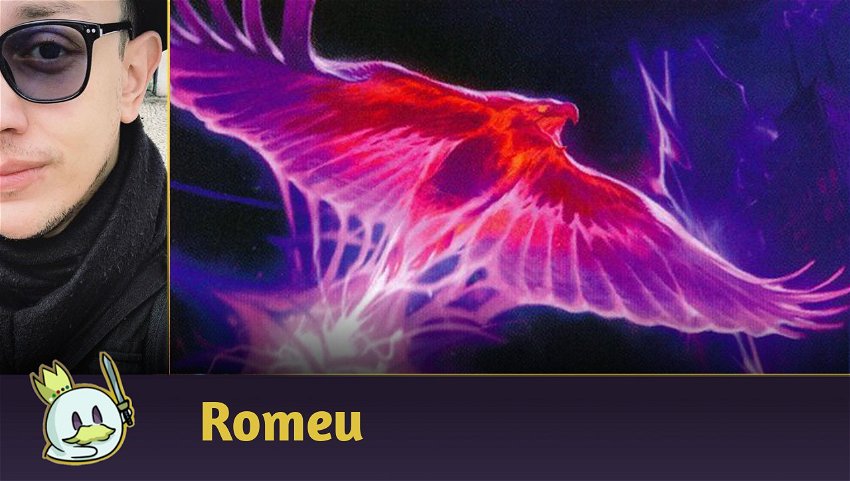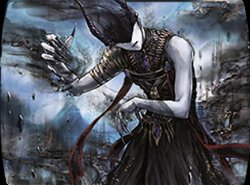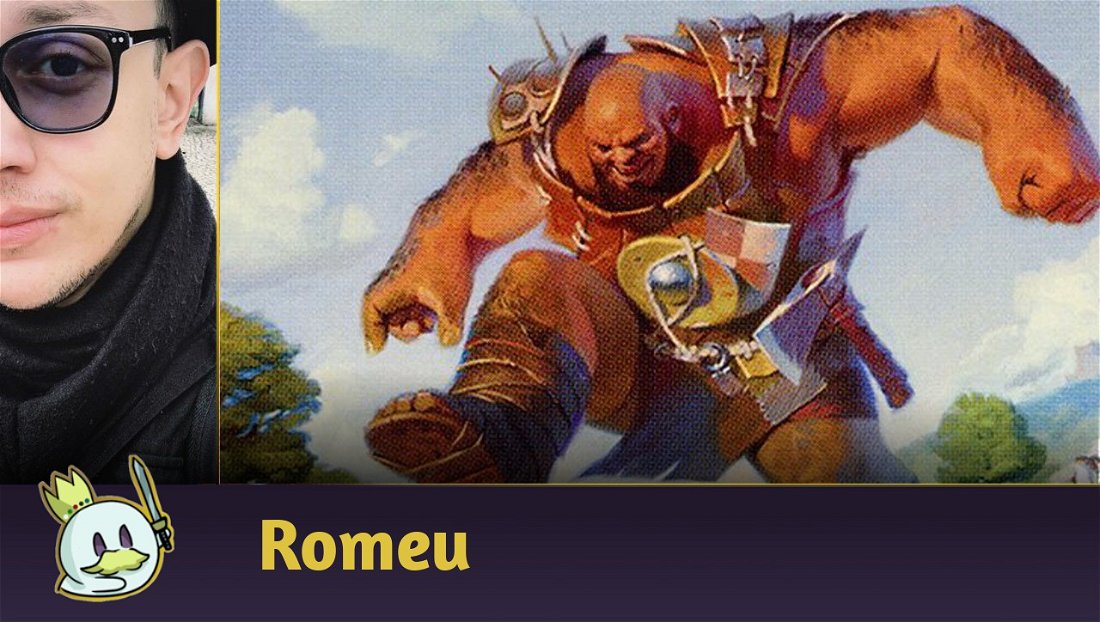The 2022 Pioneer Challenger Decks had their decklists revealed last week, featuring four different archetypes: Izzet Phoenix, Orzhov Humans, Gruul Aggro and Dimir Control — each with a distinct strategy and ready to play out of the box, making it perfect for tournaments at local stores.
The main focus of this product is to serve as a gateway for players to enter an eternal format without the need to incessantly search for older cards that aren't always easily available, guaranteeing them the experience of enjoying the format from a sealed product found at any local store.
Ad
Unlike what we did last year, where we analyzed the four decks and gave upgrade tips, in this one we will review each one individually, with an in-depth view of what is the proposal that the list seeks to provide and which directions we can take based on its content.
And to start this series, let's talk about the most controversial among them: Izzet Phoenix.
Out of the Box - Izzet Phoenix
In case you missed it, this is the Izzet Phoenix decklist:
Yes, it's confusing and almost offensive to call itself Izzet Phoenix, as it only has two copies of Arclight Phoenix while also carrying two copies of Expressive Iteration — which was banned from Pioneer on June.
As with Standard Challenger Decks this year — where Mono White Aggro came with four copies of Faceless Haven — Wizards made an exception where, if you play with the exact 75 cards from the maindeck and sideboard, you can use copies of the banned card present on it.
We can see the good intentions in adding Expressive Iteration to the decklist, given it is a multi-format staple and retains a relatively high price for an uncommon, which would make it difficult to acquire in a world where it would still be legal. However, it's also clear that they probably pulled something wrong to include these copies: again, it doesn't make sense for a product called Izzet Phoenix to only have two Arclight Phoenix — it's literally the heart of the strategy as we know it in Pioneer since its inception.
This is a grotesque mistake in the design and planning of the deck because it has four Crackling Drake, of which you would normally run one or at most two, and even remove both Thing in the Ice to have four Arclight Phoenix alongside Crackling Drake would make more sense than this erratic creature composition in the final product, even if it made the list a bit worse.
However, it is evident that the R&D's idea was to make Izzet Phoenix the "flexible archetype" among the four decks: one that follows a middle ground between two directions, and it is up to the player to decide which of the two routes is more interesting and/or advantageous: Izzet Phoenix or Izzet Drake, which still does well in the competitive scene.
Let's dissect the list to better understand its functionality.

Starting with manabase, on the one hand R&D did well to include a Steam Vents and a Shivan Reef playset, but the numbers of Temple of Epiphany and Sulfur Falls seem to have been swapped for no reason: Scry 1 is cool and helps fix the topdeck, but Izzet Phoenix is a Tempo strategy that doesn't want to waste a turn with tapped lands if they don't add anything relevant.
If you were to have a playset of a land that enters tapped, it would be something that actually matters, even Wandering Fumarole — which would be an additional threat while fixing your manabase.

Ad
As mentioned above, the creature core is weird and completely blurry: you want to throw stuff into the graveyard, you want to cast multiple spells, but a significant portion of the list doesn't interact well with your threat sequencing, as you will often be forced to tap yourself out to cast Crackling Drake, or even have to avoid playing too many spells to not return it to your hand in a favorable situation with Thing in the Ice.
In the end, the threat sequencing from the above list is poor and inefficient. You'll rarely get the more explosive plays that competitive Izzet Phoenix offers, and your deck doesn't interact as well to the point where the Crackling Drake plan carries the game on its own due to a relatively high number of spells aimed at what Arclight Phoenix demands.

The list features a mix of draws and cantrips typical of a Turbo Xerox strategy, with 24 means to draw cards in your maindeck. And just like the creature base, they don't fully interact well with both proposals.
While Consider, Opt, Treasure Cruise and Expressive Iteration would easily be present in both strategies, Pieces of the Puzzle gets worse as you reduce the number of Arclight Phoenix on the list, given that its main use is precisely to serve as a "mini"-Dig Through Time that rewards you by speeding up the amount of cards in the graveyard to reanimate the birds and cast Treasure Cruise.
That said, except for that spell, its cantrip composition is pretty solid and likely helps to maintain consistency.

The interaction package has 10 cards, and could easily go up to 12, especially considering there are only two Thing in the Ice. They will probably be enough to deal with the threats of more aggressive archetypes long enough to stabilize with Crackling Drake, but you may spend too much time needing to pick them up with cantrips at the right time, which is a dangerous proposition.
That said, the flexibility of the removals is a plus point in a Metagame as diverse as Pioneer, and while Lightning Axe also interacts poorly without Arclight Phoenix, it handles large threats that red removals have difficulties to deal with.

The Sideboard is much more decent and "as expected" than the Maindeck, with more flexible removals like Lava Coil, Abrade and Sweltering Suns — carefully selected not to be counter-interactive, as would be the case with Anger of the Gods.
This in addition to necessary counterspells, such as Mystical Dispute and Invasive Surgery, and finally, Narset, Parter of Veils being a powerful tech in attrition games and one of the main weapons of the archetype against the mirror match, makes its sideboard solid enough for a wide array of matchups.
Ad
Upgrade Guide
Coming straight out of the box, the Izzet Phoenix is somewhere between an Arclight Phoenix archetype and a Crackling Drake archetype, and in order to perform the necessary upgrades, the player will need to decide which route they prefer to take.

The good news is that in both cases, despite being useful, Ledger Shredder isn't mandatory: It is present on average of 44% of Izzet Phoenix lists today, and less than 20% of Izzet Drake — so you can upgrade the list without necessarily needing one of today's most expensive staples.
So, once you've set your route, one change will become mandatory before any other: remove two copies of the option you didn't choose, plus two Expressive Iteration, to maximize the numbers of Thing in the Ice , plus more copies of things that actually interact with the chosen proposal.
Manabase

In both cases, however, you will need to improve your manabase. In a budget-oriented first option, you could start with:
OUT:

IN:

However, Shock Lands are often worth the investment, so a more streamlined option would be:
OUT:

IN:

This way, you maximize the possibility of having access to the colors you need early-game, while also getting another wincondition with Wandering Fumarole without having to spend that much money.
That said, your priority of the other lands should be, in the respective order and always focusing on the playset: Spirebluff Canal, Riverglide Pathway, Stormcarved Coast, then two copies of Hall of Storm Giants and one Otawara, Soaring City.
The other options must be weighted according to the needs of the Metagame, not being specifically mandatory.
As for the pertinent changes for each archetype, we have:
Izzet Phoenix
IN:

OUT:

First, you need to maximize threats by increasing the number of Arclight Phoenix and Thing in the Ice to stay on top of the most played lists in the Metagame today, while Expressive Iteration will have to come out of anyway and there's no need for four Crackling Drake in this variant, while two can help as additional threats.
IN:

OUT:

In a universe without Expressive Iteration, we need more efficient methods of filtering our draws and streamlining our game plan. In that sense, despite not offering virtually two cards as the banned spell, Strategic Planning gives impressive filtering while quickly feeding the graveyard to Treasure Cruise.
Ad
Izzet Charm, while nice and flexible, is too conditional in all its modules, being less useful in as the game extends. So, you hardly want more than one copy in a broader Metagame.
IN:

OUT:

With more Arclight Phoenix, Lightning Axe automatically becomes the best removal of the archetype, as it handles 90% of the permanents that matter in the current Metagame for just one mana.
Chart a Course, while useful and offering pseudo-card advantage, is often too slow and offers fewer benefits than other spells, so it ends up leaving so that more important things can come in.
Sideboard

Sideboarding is often a matter of meeting the needs of the Metagame you play in, so options can be very broad and conditional.
And with the Izzet Phoenix being a Turbo Xerox, we can diversify its range of answers.
IN:

OUT:

Young Pyromancer is a necessary response against Liliana of the Veil, while also excellently blocking some Aggro decks. Aether Gust is useful against Mono Green Devotion and archetypes with red such as Mono Red, Gruul Aggro, Boros Heroic, Jund Sacrifice, among others.
Although cheaper and therefore added, Spell Pierce loses its usefulness in the long run, so you might consider Negate instead. Finally, Chandra, Torch of Defiance is a great card for attrition games, and you might want one more Planeswalker in addition to her if Midranges and Controls recur at the events you attend.
Remember that the Sideboard is often a matter of adapting to the Metagame, so adjust yours to suit your needs.
Other Upgrades
With these changes, the list will be consistent enough to perform well in local stores and small events like FNM, allowing you to have fun and compete while chasing the necessary upgrades for your manabase.
However, there are two other upgrades I recommend for the list, in addition to the options mentioned above:
IN:

OUT:

The Temporal Trespass combo with Galvanic Iteration is one of the most explosive plays available to Izzet Phoenix — which is why the extra turn spiked massively early in the RCQ season, as games are often gained from a combination of transforming Thing in the Ice with this combo and attacking to lethal for three turns in a row.
IN:

OUT:

This is a personal tech and few players adopt it, but Dig Through Time is a compelling Delve spell and is often more effective than Treasure Cruise when you are looking for specific cards, and it also allows you to play around Narset, Parter of Veils and keep the lands untapped during the opponent's turn for whatever reason is necessary.
Ad
Also, because it's an Instant, it also works better when we need to play around graveyard hate.
Izzet Drake
IN:

OUT:

As with the version above, in Izzet Drake we removed the less important piece and Expressive Iteration to maximize the amount of Thing in the Ice and include Kazuul's Fury, which not only increases the amount of lands in our manabase, but it also works in a sort of 2-card combo alongside Crackling Drake where you can attack with the creature and, after combat, sacrifice it to deal lethal damage to the opponent.
There are many routes you can take with this archetype: something closer to Izzet Control with Hullbreaker Horror and/or Niv-Mizzet, Parun, or a pseudo-lock version of Narset, Parter of Veils with Day's Undoing, among others.
However, the focus here will be the version of which the Challenger Deck list proposes: a Midrange/Control with cheap answers and that runs Crackling Drake and Thing in the Ice as winconditions.
IN:

OUT:

As the focus of this strategy isn't to perform a spell streak, and we are trying to be more reactive towards how the opponent behaves, Treasure Cruise is an under-optimized option compared to Dig Through Time, that increases the search scope for a specific answer and/or threat and can be cast on your opponent's turn.
IN:

OUT:

Chart a Course doesn't interact with Izzet Drake's proposal, works at Sorcery-Speed and doesn't impact the opponent's board position, so it can be replaced by Censor, which works as an occasional Tempo play that forces the opponent to play around while not losing late-game utility due to cycling.
IN:

OUT:

Fiery Impulse is more comprehensive than Flame-Blessed Bolt, while Lightning Axe doesn't interact well with the archetype, and Anger of the Gods helps to hold the "go wide" strategies, such as Humans, Spirits, Mono Red Aggro, among others.
You can exchange Anger of the Gods for Sweltering Suns, which is already present in the box, but Theros' sweeper works better against recurring threats while not being expensive to the point you need to reconsider the investment.
IN:

OUT:

Divide By Zero is a comprehensive temporary answer that was so important to Standard that it was eventually banned. In a universe full of Midranges and other archetypes that seek to maximize mana usage each turn, it will commonly be a pseudo-Time Walk that offers you a looting or something important from your Sideboard.
And in the Lessons, you have ways to guarantee your land drops, extra draws, or even a wincondition.
Izzet Charm and Lightning Axe are out as they are too conditional or offer a card disadvantage.
Ad
IN:

OUT:

Pieces of the Puzzle is the worst card in the deck when we don't have Arclight Phoenix to recur from the graveyard, so we swapped it and the last copy of Treasure Cruise for more cheap interactions.
These slots are relatively flexible, so you can add whatever seems most pertinent to your local Metagame.
Sideboard
IN:

OUT:

With Divide By Zero, we have access to Lessons, and the best options available for the archetype are Environmental Sciences to guarantee the land drops, Mascot Exhibition as an extra wincondition and Teachings of the Archaics for attrition matchups.
Sweltering Suns has been moved to the Maindeck, or replaced with Anger of the Gods, and Invasive Surgery is too narrow.
IN:

OUT:

Hullbreaker Horror is a useful feature against Control if the match goes on too long, becoming a trump card if played with some backup, Negate and Disdainful Stroke are conditional counterspells, but they deal with troublesome spells in the late-game, and Aether Gust is a standard means of delaying many competitive strategies today.
Narset, Parter of Veils is excellent in the variants with Day's Undoing and Collective Defiance, but in the version we adopted, it does very little even on the Sideboard and therefore was removed from the list. Abrade and Mystical Dispute were over-represented in the original list.
With these changes, your decklist will look like this:
Going deeper, you can consider other variants as per your interest, but the main focus should be on manabase upgrades.

Conclusion
That's all for today.
If you want to see the most competitive lists and the most used card variants, our Metagame page is always updated with Challenges and Leagues.
You can find Izzet Phoenix's lists here and Izzet Drake's here
.
If you have any questions, feel free to leave them in the comments. Thanks for reading!








— Comments0
Be the first to comment